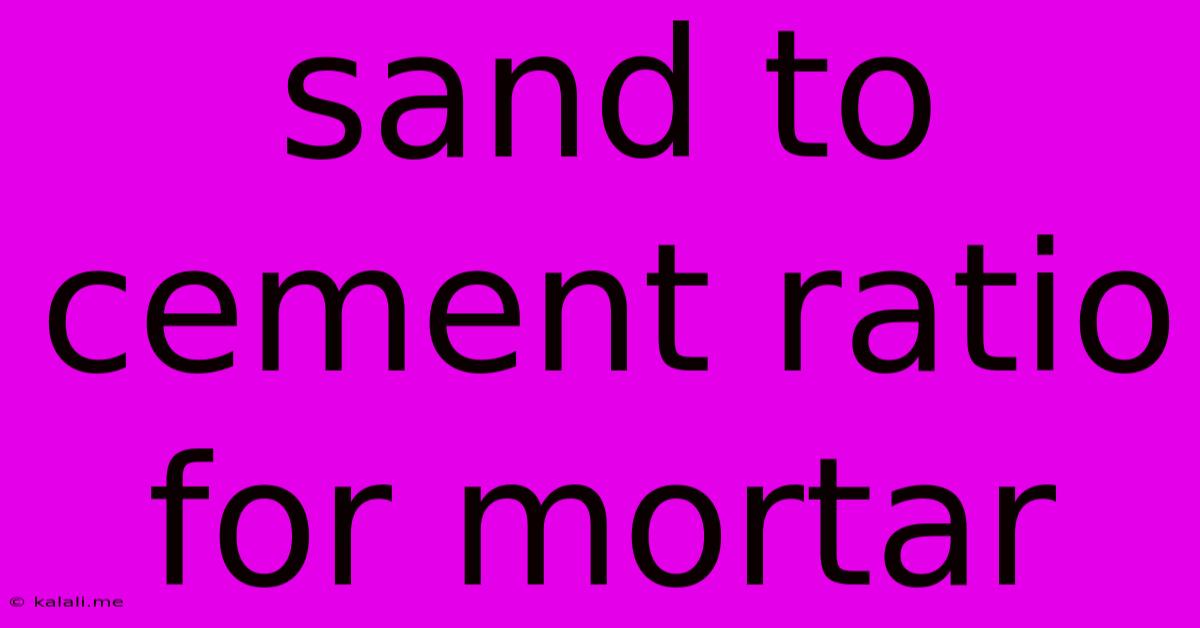Sand To Cement Ratio For Mortar
Kalali
May 19, 2025 · 3 min read

Table of Contents
Finding the Perfect Mix: Understanding Sand to Cement Ratio for Mortar
Knowing the ideal sand to cement ratio for your mortar mix is crucial for achieving the desired strength, workability, and durability. Getting this ratio wrong can lead to a weak, crumbly mortar that fails to hold your bricks or blocks securely, or a mix that's too stiff and difficult to work with. This article will guide you through understanding the different factors influencing the ratio and how to achieve the perfect mix for your project.
What is Mortar and Why is the Ratio Important?
Mortar is a binding agent used in construction, primarily composed of cement, sand, and water. The ratio of sand to cement directly impacts the mortar's properties. A higher sand content reduces cost but may compromise strength, while a higher cement content increases strength and durability but increases cost and can make the mix harder to work with. The perfect ratio is a balance between these factors, depending on the application.
Factors Affecting Sand to Cement Ratio:
Several factors influence the optimal sand-to-cement ratio:
- Type of Cement: Different cement types (Portland cement, masonry cement, etc.) have varying properties that affect the required sand ratio. Portland cement, for instance, often requires a different ratio than a specialized masonry cement.
- Type of Sand: The quality and grading of sand significantly impacts the mix. Fine, well-graded sand generally requires a slightly higher cement content compared to coarse sand. The presence of impurities in the sand can also affect the mortar's strength.
- Application: The intended use of the mortar dictates the necessary strength. Mortar for bricklaying requires a different ratio compared to that used for rendering or pointing. Bricklaying mortar generally needs higher strength.
- Desired Workability: The desired consistency of the mortar also plays a role. A stiffer mix is suitable for applications requiring precision, while a more workable mix is preferred for larger projects.
- Environmental Conditions: Extreme temperatures or high humidity can affect the setting time and strength of the mortar, potentially requiring adjustments to the sand-cement ratio.
Common Sand to Cement Ratios:
While there isn't one universally perfect ratio, here are some common guidelines:
- 1:3 (Cement:Sand): This is a strong mix, often used for applications requiring high strength, like load-bearing brickwork. It's a relatively expensive option due to the higher cement content.
- 1:4 (Cement:Sand): A common ratio for general bricklaying and blocklaying. It provides a good balance between strength and workability.
- 1:5 (Cement:Sand): This ratio is suitable for less demanding applications like rendering or pointing, where high strength isn't as critical. It's a more economical option.
- 1:6 (Cement:Sand): This is generally used for applications where a less strong but more workable mortar is needed. However, it’s important to assess the structural integrity needs carefully for this ratio.
Tips for Achieving the Right Mix:
- Use a consistent measuring method: Use a volume-based measurement (e.g., buckets or wheelbarrows) to maintain consistent ratios.
- Add water gradually: Gradually add water to the dry mix while mixing, ensuring even consistency. Avoid adding too much water at once, as this can weaken the mortar.
- Mix thoroughly: Ensure the cement and sand are thoroughly mixed before adding water to prevent segregation and ensure uniformity.
- Check the consistency: The mortar should be workable but not too runny or too stiff. It should adhere well to the bricks or blocks.
Conclusion:
The ideal sand to cement ratio for mortar depends on several factors. Understanding these factors and using the guidelines provided will help you achieve the optimal mix for your project, ensuring strength, durability, and a successful construction outcome. Remember, always prioritize safety and consult with professionals if you're unsure about the correct mix for a specific application.
Latest Posts
Latest Posts
-
Can You Use Normal Salt In A Dishwasher
May 20, 2025
-
How To Reheat Cottage Pie From Fridge
May 20, 2025
-
Can Sod Be Laid Over Grass
May 20, 2025
-
How To Clean Off Mortar From Brick
May 20, 2025
-
Meaning Of Tall Dark And Handsome
May 20, 2025
Related Post
Thank you for visiting our website which covers about Sand To Cement Ratio For Mortar . We hope the information provided has been useful to you. Feel free to contact us if you have any questions or need further assistance. See you next time and don't miss to bookmark.